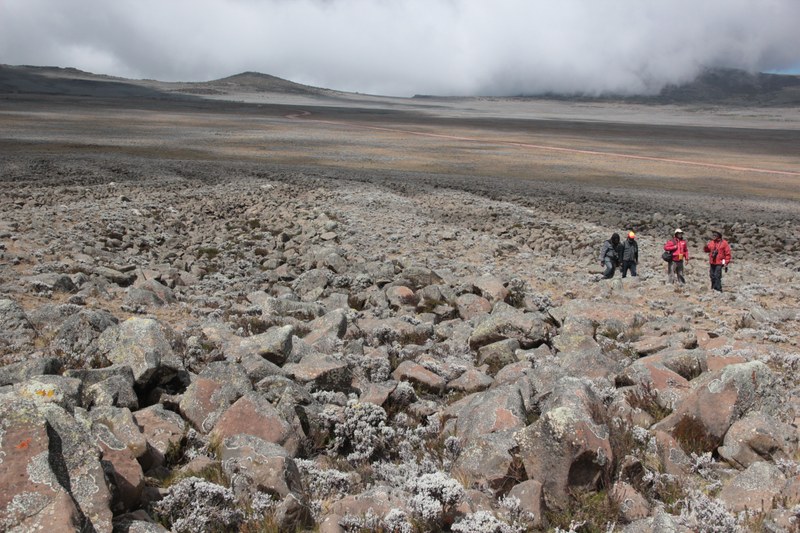Main Content
P6 - Glacial Chronology
PI: Heinz Veit | Naki Akçar
Post-doc: Alexander Groos
Overview
The glacial history will be assessed by moraine mapping and dating of moraines by means of organic samples from turf basins (youngest stages) and 36 Chlor cosmogenic nuclides (for older big boulder moraines and boulder streams. The determination of extension and age of moraines is not only important for the reconstruction of the paleo circulation patterns, but is pivotal to distinguish between settlements/rockshelters of warm/wet climates of Interglacials/the Holocene or those of cold/dry climates like the LGM, when glacial meltwater streams are supposed to be a crucial resource for wildlife and hunters.
Achievements
- Reconstruction of the valley and plateau glaciation extent
- Established glacial chronology provides evidence for glaciation
- Measured annual soil temperatures on the Sanetti Plateau and assumed conditions for the formation of permafrost features
- Mapping and analysing past periglacial features
Objectives
- Establishment of a glacial chronology for the Arsi Mountains
For calculating climatic changes and meltwater runoff from paleo glacier outlines, knowing the extent and timing of past glaciations is mandatory. Since the complex glacial situation on the Sanetti Plateau prevents the accurate reconstruction of the former ice extent and volume, incorporating the nearby Arsi Mountains in the climatic and glaciological analysis is essential. The exposure ages from the Arsi and Bale Mountains will be combined to establish a robust glacial chronology for the Southern Ethiopian Highlands. - Calculation of the Late Pleistocene temperature and precipitation changes in the Southern Ethiopian Highlands from inverse glacier mass balance modelling
Inverse mass balance modelling applied to the outlines of paleo glaciers in mountain areas has been proven a suitable tool for the quantification of temperature and precipitation changes from glacier extent variations (e.g. Kull et al. 2002, 2008; Huintjes et al. 2016). Glacier extents in the Arsi Mountains varied temporally (within one valley) and spatially (between valleys). The spatio-temporal differences in glacier size are a strong indicator for a variable local climate. - Modelling of the dynamic evolution of the paleo glaciers and ice cap in the Bale Mountains over the Late Pleistocene
Higher-order ice-flow models are a well-established tool for simulating the dynamic evolution of glaciers and ice caps in response to climate variations (e.g. Zekollari et al. 2017; Seguinot et al. 2018). P6 will make use of the coupling of the open-source ice-flow models Elmer/Ice (Gagliardini et al. 2013) and ParaIlel Ice Sheet Model PISM (e.g. Winkelmann et al. 2011; Ziemen et al. 2016) with the glacier surface mass balance model glacierSMBM (Groos et al. 2017; Groos & Mayer 2017) for simulating the Late Pleistocene glacial evolution of the northern valleys in the Bale Mountains and the central ice cap on the Sanetti Plateau. The aim of the dynamic modelling is to study the variability of the valley glaciers between the different glacial stages, constrain the extent of the former plateau glaciation and test the plausibility of glaciers being absent along the southern escarpment during the last glacial cycle. Glacial and periglacial features mapped and dated within Phase 1 will serve for the validation of the modelled glacier extent, ice thickness and timing of glacial stages.


Figure 1 & 2: Boulder Streams; Taking samples of boulders at the Sanetti Plateau, Ethiopia
Publications
Alexander A. R.,Niederhauser J., Lemma B., Fekadu,, M., Zech, W., Hänsel, F.,Wraase, L., Akçar, N., and Veit, H.: An hourly ground temperature dataset for 16 high-elevation sites (3493–4377 m a.s.l.) in the Bale Mountains, Ethiopia (2017–2020) (2022), Earth Syst. Sci. Data, 14, 1043–1062.
https://doi.org/10.5281/zenodo.6047457
Groos, A. R., Akçar, N., Yesilyurt, S., Miehe, G., Vockenhuber, C., and Veit, H (2021).: Nonuniform Late Pleistocene glacier fluctuations in tropical Eastern Africa, Sci. Adv., 7, eabb6826, 2021.
DOI: 10.1126/sciadv.abb6826
Groos, A. R., Niederhauser, J., Wraase, L., Hänsel, F., Nauss, T., Akçar, N., and Veit, H. (2021): The enigma of relict large sorted stone stripes in the tropical Ethiopian Highlands, Earth Surf. Dynam., 9, 145–166.
https://doi.org/10.5194/esurf-9-145-2021
Groos A. R., Akçar N, Vockenhuber C and Veit H (2018) Glacial chronology of the Bale Mountains in southern Ethiopia. Geophysical Research Abstracts 20, 1-1.
Ossendorf G., Groos A.R., Bromm T, Tekelemariam MG, Glaser B, Lesur J, Schmidt J, Akçar N, Bekele T, Beldados A, Demissew S, Kahsay TH, Nash BP, Nauss T, Negash A, Nemomissa S, Veit H, Vogelsang R, Woldu Z, Zech W, Opgenoorth L & Miehe G (2019) Middle Stone Age foragers resided in high elevations of the glaciated Bale Mountains, Ethiopia, Science 365 (2019), 583-587.
DOI: 10.1126/science.aaw8942
PhD Thesis
Groos, A.R. (2021) Glacial and periglacial history of the Bale mountains, southern Ethiopian highlands
Master Thesis
Niederhauser, J. (2019) Soil temperatures in the Bale Mountains - The dynamics of soils in an Afroalpine ecosystem.







